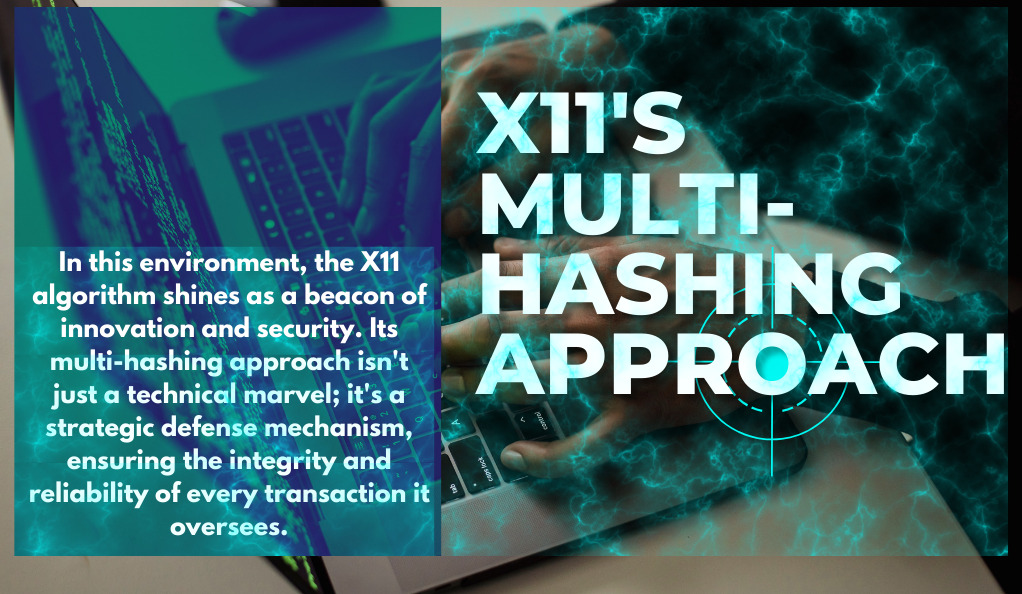In the vast and ever-evolving world of cryptocurrencies, the underlying technology and algorithms play a pivotal role in ensuring the security, reliability, and integrity of transactions. One such algorithm that has garnered significant attention in the crypto community is X11. But what is X11, and why is its security framework so crucial in the digital currency landscape?
What is X11?
X11 is a chained hashing algorithm used for several cryptocurrencies, most notably Dash. Unlike traditional cryptographic algorithms that rely on a single function, X11 is unique in its approach. It employs a sequence of 11 different scientific hashing algorithms. This chained approach not only enhances security but also offers better resistance against potential vulnerabilities.
Why Security is Paramount in Cryptographic Algorithms
The primary purpose of any cryptographic algorithm is to ensure data security, and in the context of cryptocurrencies, this translates to the safety of transactions and holdings. A robust cryptographic algorithm:
- Prevents Double Spending: The very essence of digital currency is that it’s a string of data. Without robust security, this data can be duplicated or falsified, leading to the notorious ‘double-spending’ problem.
- Guards Against Attacks: With increasing interest in cryptocurrencies, they’ve become a lucrative target for cybercriminals. A strong cryptographic backbone is essential to fend off various attacks, from 51% attacks to more sophisticated threats.
- Ensures Anonymity and Privacy: One of the appeals of cryptocurrencies is the promise of privacy. A secure algorithm ensures that transaction details remain confidential, protecting user identities and activities.
Understanding Double-Spending: The Cryptocurrency Nightmare
The concept of double-spending is akin to using the same dollar bill to make two separate purchases. In the physical world, this is impossible due to the tangible nature of currency. However, in the digital realm, where assets are essentially data, the risk of duplication becomes very real. This potential flaw is what makes double-spending a significant concern for any digital currency.
The Mechanics of Double-Spending
At its core, double-spending involves spending the same digital coin more than once. Here’s a simplified breakdown:
- Initial Transaction: Alice sends Bob a digital coin.
- Duplicitous Transaction: Almost simultaneously, Alice sends the same coin to Charlie, attempting to spend it twice.
In a vulnerable system, both transactions might get verified, leading to a scenario where Alice has effectively created money out of thin air. This undermines the very foundation of a cryptocurrency’s value and trustworthiness.
Why Double-Spending is a Threat to Digital Currencies
- Erodes Trust: If double-spending becomes rampant, it erodes the trust users have in a cryptocurrency. Why would anyone accept digital currency if its authenticity is in doubt?
- Impacts Value: The value of any currency, digital or otherwise, is based on its scarcity and trust. Double-spending artificially inflates the number of coins in circulation, potentially leading to devaluation.
- Stifles Adoption: For cryptocurrencies to gain mainstream acceptance, they need to be seen as reliable. Double-spending incidents can deter businesses and individuals from adopting or accepting digital currencies.
How X11 Counters Double-Spending
The multi-hashing approach of X11 plays a crucial role in preventing double-spending. By chaining 11 different hashing algorithms, X11 ensures that any attempt to double-spend would require an attacker to compromise not just one, but multiple algorithms, a feat that’s computationally expensive and nearly impossible with current technology.
Moreover, the decentralized nature of cryptocurrencies that use X11, combined with the Proof-of-Work consensus mechanism, ensures that transactions are verified by multiple parties. This distributed verification makes it exceedingly difficult for any single entity to introduce a fraudulent transaction into the blockchain.
X11’s Multi-Hashing Approach: A Layered Defense

In the realm of cryptographic algorithms, diversity often equates to strength. The X11 algorithm stands as a testament to this principle, employing a sequence of 11 different hashing functions. This multi-hashing approach isn’t just a gimmick; it’s a strategic design choice that offers multiple layers of security.
The Science Behind Multi-Hashing
At its essence, a hashing function takes an input (or ‘message’) and returns a fixed-size string of bytes. The output, typically a ‘digest’, is unique to the given input. Even a minuscule change in the input will produce a drastically different output. This characteristic is vital for verifying the integrity of data and transactions.
By chaining together 11 different hashing algorithms, X11 ensures that any potential vulnerability in one algorithm doesn’t compromise the entire system. An attacker would need to find vulnerabilities in all 11 functions and exploit them simultaneously, a task that’s exponentially more challenging than compromising a single function.
Benefits of the Multi-Hashing Approach
- Enhanced Security: As mentioned, the diversity of hashing functions means that the vulnerability of one doesn’t spell doom for the entire system.
- Future-Proofing: If one hashing function becomes obsolete or compromised in the future, the presence of ten others ensures the system remains secure. This design also allows for the potential replacement of outdated functions without overhauling the entire algorithm.
- ASIC Resistance: Cryptocurrencies have seen the rise of specialized hardware called ASICs (Application-Specific Integrated Circuits) designed to mine coins at accelerated rates. By using multiple hashing functions, X11 makes it more challenging and less economically viable to design ASICs for its mining, promoting decentralization.
- Energy Efficiency: X11 is known for being more energy-efficient compared to algorithms like SHA-256 used in Bitcoin. This efficiency results in cooler system temperatures, prolonging hardware lifespan and reducing energy costs.
Real-World Application: Dash and Beyond
Dash, one of the most prominent cryptocurrencies to adopt the X11 algorithm, has benefited immensely from its security features. The multi-hashing approach, combined with other unique features like ChainLocks (which we’ll explore later), has made Dash one of the more secure and reliable cryptocurrencies in circulation.
However, Dash isn’t the only coin to recognize the potential of X11. Several other cryptocurrencies have adopted or are considering the X11 algorithm, drawn by its promise of enhanced security and efficiency.
Proof-of-Work and X11: A Match Made for Security
The consensus mechanism is the heartbeat of any blockchain, ensuring all transactions are verified and agreed upon by the network. Proof-of-Work (PoW) is one such consensus mechanism, and when combined with the X11 algorithm, it forms a formidable duo that ensures the utmost security and integrity of the blockchain.
Understanding Proof-of-Work (PoW)
Proof-of-Work is a consensus mechanism that requires participants (miners) to solve complex mathematical puzzles to validate and add new transactions to the blockchain. The first miner to solve the puzzle gets the privilege to add a new block and is rewarded with newly minted coins. This process is resource-intensive, requiring significant computational power and energy.
Why PoW Complements X11’s Security Features
- Decentralization: PoW promotes decentralization by allowing anyone with the necessary hardware to participate in the mining process. This decentralization ensures that no single entity has control over the network, making it resistant to malicious attacks.
- Transaction Integrity: The computational effort required in PoW ensures that it’s costly and time-consuming to introduce fraudulent transactions. When combined with X11’s multi-hashing approach, this makes double-spending and other malicious activities nearly impossible.
- Network Security: For a malicious actor to alter any part of the blockchain, they would need to redo the PoW for that block and all subsequent blocks. Given the energy and computational requirements, this is practically infeasible, especially when the X11 algorithm is in play.
The Role of Miners in Ensuring Transaction Integrity
Miners play a pivotal role in the PoW consensus mechanism. Their primary task is to validate and verify the authenticity of transactions. Here’s a step-by-step breakdown:
- Transaction Verification: Miners check the transaction details against the existing blockchain to ensure there’s no double-spending.
- Block Creation: Once verified, transactions are grouped into a block. The miner then begins the process of finding a specific value (nonce) that, when hashed, produces a result fitting certain criteria.
- Block Addition: When the correct nonce is found, the block is added to the blockchain. This block then serves as a reference for verifying future transactions.
Challenges and Criticisms
While PoW, especially when combined with X11, offers robust security features, it’s not without its criticisms:
- Energy Consumption: PoW, by design, is energy-intensive. This has raised environmental concerns, especially with large-scale mining operations.
- Centralization Risks: The rise of mining pools, where multiple miners combine their computational power, has led to concerns about potential centralization, where a few large pools could control a significant portion of the network’s mining power.
Adaptive N-Factor: X11’s Response to ASIC Dominance

As the cryptocurrency landscape evolved, so did the tools and techniques used by miners. The introduction of Application-Specific Integrated Circuits (ASICs) marked a significant shift in the mining ecosystem. While ASICs brought efficiency, they also introduced challenges related to centralization and accessibility. X11’s adaptive N-factor emerges as a solution, aiming to level the playing field.
Understanding ASICs and Their Impact
ASICs are specialized hardware designed exclusively for mining specific cryptocurrencies. They offer significant advantages over traditional CPUs and GPUs:
- Higher Efficiency: ASICs can mine at much higher speeds compared to general-purpose hardware.
- Lower Power Consumption: Despite their speed, they are often more energy-efficient than their counterparts.
However, the rise of ASICs also brought challenges:
- Barrier to Entry: ASICs are expensive, making it difficult for average individuals to participate in mining, leading to potential centralization.
- Hardware Obsolescence: Cryptocurrencies that undergo algorithm changes can render ASICs obsolete, leading to significant financial losses for miners.
Enter Adaptive N-Factor
The adaptive N-factor is a concept that introduces a variable factor into the hashing algorithm, which changes over time. This dynamic adjustment ensures that as hardware technology advances, the algorithm adapts, making it continually resistant to ASIC dominance.
Benefits of the Adaptive N-Factor in X11
- Promotes Decentralization: By continually adjusting the algorithm’s complexity, the adaptive N-factor ensures that no single hardware type, including ASICs, can dominate the mining landscape for extended periods.
- Extends Hardware Lifespan: Regular miners using GPUs won’t find their hardware becoming obsolete quickly. The adaptive nature means that GPUs remain relevant for longer, ensuring a more inclusive mining community.
- Security Enhancements: A decentralized mining environment is inherently more secure. With a broader distribution of miners, the network becomes more resistant to 51% attacks and other potential threats.
Challenges of Implementing Adaptive N-Factor
- Software Updates: As the N-factor changes, miners need to ensure their software is up-to-date, which can be a logistical challenge.
- Potential for Centralization: If not carefully managed, there’s a risk that large mining operations could still find ways to optimize and potentially centralize, albeit at a higher cost.
ChainLocks: X11’s Solution to 51% Attacks
One of the most significant threats to any blockchain-based system is the dreaded 51% attack. In such an attack, a single entity gains control of the majority of the network’s mining power, enabling them to double-spend coins and disrupt the integrity of the blockchain. X11, in its pursuit of unparalleled security, introduces ChainLocks—a feature designed to counteract these potential attacks.
Understanding the 51% Attack
Before delving into ChainLocks, it’s essential to grasp the mechanics and implications of a 51% attack:
- Majority Control: If a miner or mining pool gains over 50% of the network’s computational power, they can effectively control the addition of new blocks to the blockchain.
- Double Spending: With this control, the attacker can spend coins and then reverse those transactions, effectively ‘double-spending’ their digital assets.
- Blockchain Reorganization: The attacker can also rewrite recent parts of the blockchain, leading to loss of trust and potential financial losses for other users.
ChainLocks: A Protective Shield

ChainLocks is a mechanism that leverages the network’s node infrastructure to secure the blockchain further. Here’s how it works:
- Masternode Selection: The network randomly selects a group of masternodes—a type of full node that has a collateral “stake” in the cryptocurrency.
- Block Verification: Once a new block is mined, the selected masternodes verify the block. If a consensus is reached among them, the block is locked in place, making it immutable.
- Rapid Consensus: This process happens rapidly, often within seconds, ensuring that the blockchain remains secure and up-to-date.
Benefits of ChainLocks in X11
- Enhanced Security: With ChainLocks, even if an attacker manages to gain 51% of the network’s mining power, they cannot alter a block once it’s been locked by the masternodes. This effectively neutralizes the threat of a 51% attack.
- Faster Transaction Confirmations: Since blocks are locked in quickly, transactions can be considered secure after just one confirmation, speeding up the overall transaction process.
- Increased Network Confidence: Knowing that the blockchain is safeguarded against one of the most significant potential attacks increases user and investor confidence in the cryptocurrency.
Challenges and Considerations
While ChainLocks offer enhanced security, they also introduce new considerations:
- Masternode Centralization: If masternodes become too centralized, it could introduce potential vulnerabilities. Ensuring a broad and decentralized distribution of masternodes is crucial.
- Collateral Requirements: Running a masternode often requires a significant amount of cryptocurrency as collateral. This requirement could be a barrier for some users.
Future-Proofing: X11’s Commitment to Ongoing Security Enhancements

In the digital age, resting on one’s laurels can be a recipe for obsolescence. The world of cryptocurrencies and blockchain is no exception. With hackers becoming more sophisticated and potential threats evolving, it’s crucial for cryptographic algorithms to stay ahead of the curve. X11, with its forward-thinking design and commitment to innovation, is poised to meet the challenges of tomorrow.
The Evolving Nature of Cyber Threats
The digital realm is a battleground. As security measures become more advanced, so do the techniques employed by malicious actors. Some of the evolving threats include:
- Quantum Computing: While still in its infancy, quantum computing has the potential to disrupt traditional cryptographic methods. Its ability to solve complex problems rapidly could make certain encryption techniques vulnerable.
- Sophisticated Malware: Advanced malware can target cryptocurrency wallets, exchanges, and even blockchain networks, aiming to steal funds or disrupt operations.
- Sybil Attacks: In these attacks, a single adversary controls multiple nodes on a network, potentially disrupting its operations or spreading false information.
X11’s Adaptability and Forward-Thinking Design
X11 was designed with the future in mind. Its multi-hashing approach is just the tip of the iceberg. Here’s how X11 is geared for the challenges of tomorrow:
- Modular Design: The use of 11 different hashing functions means that if one becomes vulnerable or outdated, it can be replaced without overhauling the entire system.
- Active Development Community: Behind X11 is a community of dedicated developers and cryptographers. They continuously monitor the algorithm’s performance, ensuring it’s optimized and secure.
- Open-Source Nature: Being open-source means that X11 benefits from the collective expertise of the global developer community. Any potential vulnerabilities can be quickly identified and addressed.
Staying Ahead of Quantum Computing
One of the most significant potential threats on the horizon is quantum computing. X11’s developers are acutely aware of this. While the full implications of quantum computing on cryptography remain to be seen, proactive measures, including research into post-quantum cryptographic methods, are being considered to ensure X11 remains resilient.
Conclusion
In the rapidly evolving world of digital currencies, X11 stands out as a beacon of innovation and security. Its unique multi-hashing approach, combined with features like ChainLocks and the adaptive N-factor, showcases a commitment to safeguarding digital transactions against present and future threats. The challenges in the crypto realm are ever-growing, from double-spending to potential quantum computing disruptions. Yet, X11, with its forward-thinking design and active community support, remains resilient and adaptable. As we navigate the complexities of the digital currency landscape, X11 serves as a testament to the balance of robust security, efficiency, and inclusivity.
At axerunners.com, our goal is to furnish well-rounded and trustworthy information regarding cryptocurrency, finance, trading, and stocks. Nonetheless, we avoid providing financial advice and instead encourage users to conduct their own research and meticulous verification.
Read More













